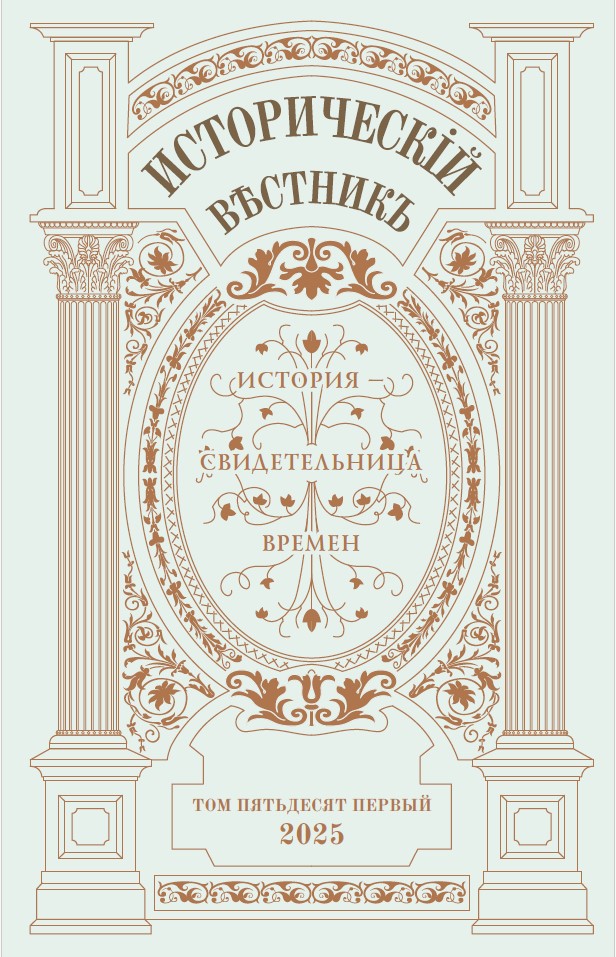Editorial
The fifty-first issue of the Historical Reporter is dedicated to General History. It features two main sections: Russian History and World History. The section on Russian history, with five papers, is the most substantial. The first paper turns to Medieval Russia. The article by Vitaly V. Politov delves into the key aspects of Kozelsk's defense in the spring of 1238. Historians have always been drawn to the heroic defense of the town of Kozelsk during Batu's invasion. However, there is still no consensus as to the question of how this relatively small medieval town managed to hold out longer than the major cities of medieval Russia. This work should undoubtedly make a significant contribution to the research into this fascinating topic. The paper by Mikhail M. Yakushev addresses our publication's traditional topic of Russian clandestine services. It describes the establishment and growth of the Russian intelligence network in Constantinople after the first permanent diplomatic mission of Russia was opened on the Bosphorus. At that time, Russia needed to secure the right to navigate through the Kerch Strait and the Black Sea, with resistance from the Ottoman government. The paper explains how Russia's diplomacy and military intelligence worked together to achieve this goal. The paper by Marina V. Koroleva covers a seemingly narrow but intriguing topic: oath-bringing fees. These were payments made by guba (county) elders, sworn officials, clerks, and prison guards when taking their oaths. Although these fees are mentioned in academic literature, no one had previously explored how and why they were collected, and no one had looked into how this annual payment affected people's willingness to take oaths and perform their official duties. The Civil War in Siberia and the Far East is a topic that has been explored in several general history–themed issues of our publication. Andrey L. Kiselev prepared a paper that attempts to analyze the 1919 activities of the government led by Admiral A.V. Kolchak aimed at concealing the fact of a large amount of counterfeit money being in circulation. This aspect had not previously been explored in Russian historiography. Phaleristics is a fascinating subject that we occasionally cover in our publication. This time, we present a new paper by Sergey V. Sytin about the history of the medal «For Impeccable Service in the Prison Guard». The paper includes a detailed analysis of the awarding occasions and circulation of this medal during the reigns of Emperors Alexander III and Nicholas II.
This issue's General History section focuses on the history of the Middle East. Our journal regularly publishes papers on this topic and also dedicates entire themed issues to it. This issue features the work Dmitriy E. Mishin focusing on the Sassanid conquest of Yemen in the 6th century. These events have been given little attention in historical literature. Sergei P. Brun's paper explores the history of the church in the Byzantine period. The work focuses on the conversion of Syrian Miaphysites (Syriac Jacobites) to Chalcedonian Orthodoxy in Syria in the 10th–11th century. The author suggests a new term, «New Melkites» to describe the Muslims who were baptized during the Romanian Reconquista and the Syriac Jacobites who embraced the new faith. The Reports section features an interesting work by Fedor A. Gushchin. It is based on the memoirs of Russian and German officers whose paths crossed during the Battle of Tannenberg in 1914, a tragedy for the Russian Army. The issue also presents a Review of Grigoriy N. Lanskoy's monograph «Russian Studies and Geopolitics: The Russian Empire of the Second Half of the 19th–Early 20th Century in North American, Western European, and Domestic Historiography of the 1960s– 1990s». We are continuing our effort to publish sources related to Russian history. Our regular contributor Andrey V. Ganin composed a paper about the fate of A.E. Snesarev, an outstanding Russian military scientist, during the repressions of the 1930s. It also portrays the challenging and often tragic fates of many other former Tsarist military specialists in the employ of the Red Army.
The Historical Reporter continues its work and would like to thank our contributors for their materials.
Alexey E. Titkov, Editor-in-Chief of the Historical Reporter
Contents
Russian history
Vitaly V. Politov. Defense of Kozelsk in 1238
Mikhail M. Yakushev. Russian Secret Diplomacy in Tsargrad in 1701–1710a
Marina V. Koroleva. Charging Fees for Kissing the Cross
Andrey L. Kiselev. Counterfeit Banknotes Under Admiral A.V. Kolchak’s Russian Government, as Covered by Siberian and Far Eastern Press
Sergey V. Sytin. Service to the Tsar Never Goes Unrewarded. The Prison Guard and the Medal for Meritorious Service
World history
Dmitriy E. Mishin. The Sassanid Conquest of Yemen
Sergei P. Brun. The New Melkites: The Phenomenon of Miaphysite Conversion to Chalcedonian Orthodoxy in 10th–11th century Syria
Reports
Fedor A. Gushchin. «Short Meeting». An Episode From the History of the Battle of Tannenberg in August 1914
Reviews
The Geopolitics of Russia as Described in the Historical Literature of the 1960s–1990s. Review of G.N. Lanskoy's Monograph «Russian Studies and Geopolitics: The Russian Empire of the Second Half of the 19th–Early 20th Century in North American, Western European, and Domestic Historiography of the 1960s–1990s» (2024) RSUH, Moscow. 258 p.
Sources
Andrey V. Ganin. «There is so Much Grief...» Military Scientist A.E. Snesarev and the Repressions of the Early 1930s
Contents
Отечественная история
- Политов В.В. К вопросу об обороне Козельска в 1238 г.
- Якушев М.М. Тайная дипломатия России в Царьграде в 1701–1710 гг.
- Королева М.В. Крестоприводные пошлины при присяге губных старост, целовальников, дьячков и тюремных сторожей
- Киселев А.Л. Фальшивые денежные знаки российского правительства адмирала А.В. Колчака: в контексте сибирской и дальневосточной прессы
- Сытин С.В. Реформа тюремного устройства в Российской империи конца XIX начала XX вв. К истории тюремной стражи и её медали «За беспорочную службу»
Всеобщая история
Сообщения
Источники



